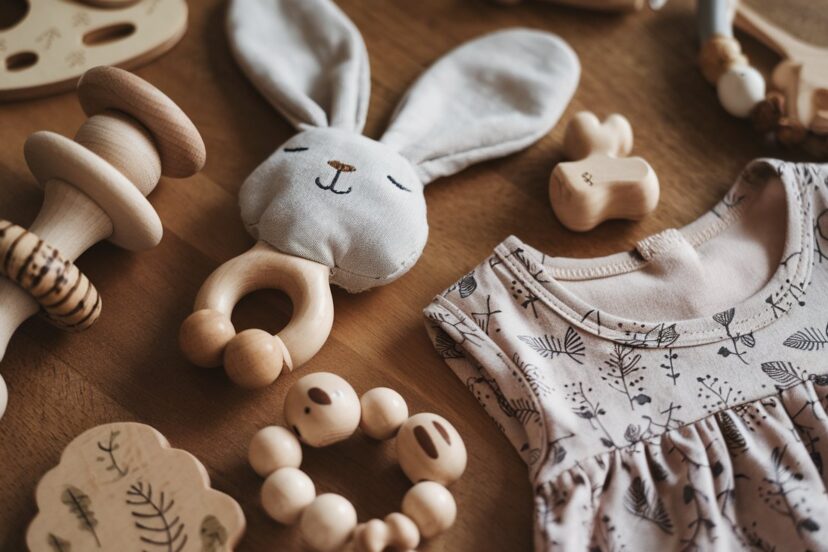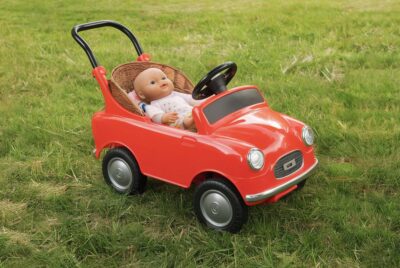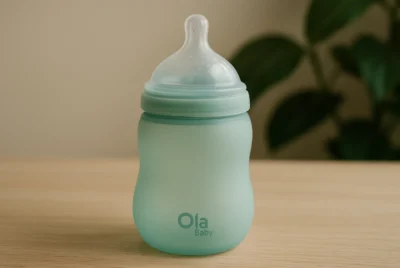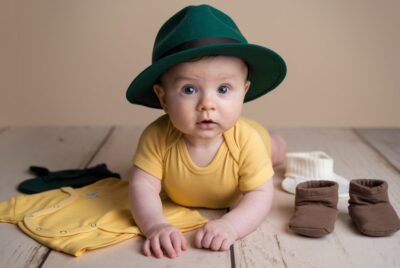Eco-Friendly Baby Products: A Sustainable Parent’s Guide
*We may earn a commission for purchases made using our links. Please see our disclosure to learn more.
When my first child was born, I became acutely aware of every product that touched their delicate skin and entered our home. The mountain of plastic, disposables, and synthetic materials piling up in our nursery made me question: what kind of impact was I creating, not just on my baby’s health, but on the planet they would grow up to inherit?
This concern isn’t unique. According to the EPA, the average baby will use 8,000 disposable diapers before potty training, contributing an estimated 3.6 million tons of diaper waste to U.S. landfills annually. Add to that the endless stream of wipes, bottles, toys, and clothing, often containing questionable chemicals and destined for centuries-long decomposition, and the environmental footprint of babyhood becomes staggering.
The good news? There’s been an explosion of genuinely eco-friendly alternatives hitting the market as more parents demand better options. After three years of research, trial and error, and conversations with environmental experts and fellow parents, I’ve compiled this comprehensive guide to help you navigate the sometimes confusing world of eco friendly baby products.
Key Takeaways
- Chemical Reduction: Eco-friendly baby products typically eliminate harmful substances like phthalates, BPA, synthetic fragrances, and flame retardants that can disrupt hormones and irritate sensitive skin.
- Waste Minimization: Sustainable options focus on biodegradability, compostability, reusability, or recyclability to reduce the staggering amount of baby-related waste entering landfills.
- Material Sourcing: The most environmentally responsible products use organic, renewable, or recycled materials harvested through sustainable practices that protect ecosystems.
- Manufacturing Ethics: Truly green companies emphasize low-carbon production methods, fair labor practices, and minimal water usage throughout their supply chains.
- Lifecycle Thinking: Consider not just how a product is made but what happens when your child outgrows it—can it biodegrade, be passed down, or be repurposed?
“We do not inherit the Earth from our ancestors; we borrow it from our children.” — Native American Proverb
Top 4 Eco Friendly Baby Products
After personally testing dozens of options and consulting with environmental scientists about their impact, these four products stand out for their genuine sustainability credentials:
1. Bambo Nature Eco-Friendly Premium Baby Diapers
Bambo Nature Premium Eco-Friendly Baby Diapers are designed with your baby's comfort and the planet in mind. Made with 100% wind power and certified with the Nordic Swan Ecolabel, these diapers provide a soft, breathable experience for your little one while being environmentally responsible. Featuring a super-absorbent core and flexible waistband, they offer a snug fit to ensure dryness and comfort, even overnight. Free from harmful chemicals and allergens, these diapers are perfect for parents who want to make sustainable choices without compromising quality.
- Eco-Friendly Materials: Made with 100% wind power and certified by the Nordic Swan Ecolabel.
- Super Absorbent: Designed to handle multiple wettings and keep baby dry all night.
- Safe for Sensitive Skin: Free from harmful chemicals and allergens, ensuring skin comfort.
- Higher Price Point: Slightly more expensive compared to traditional diapers.
- Limited Size Options: Size 5 is ideal for babies weighing 27-40 lbs, limiting availability for smaller or larger babies.
- May Not Fit All Babies Perfectly: Some parents report a slightly less snug fit for babies with very slim waists.
These award-winning diapers have transformed my perspective on what’s possible in sustainable diapering. Made in Denmark under strict EU environmental regulations, they’re produced with sustainable forestry pulp in a zero-waste facility powered largely by wind energy. Unlike many “eco” diapers that simply reduce chlorine or add a token plant-based ingredient, Bambo Nature eliminates harmful chemicals throughout the production process.
They’ve earned astonishing certifications, including the Nordic Swan Ecolabel, dermatological testing approval, and FSC certification for responsible forestry practices. While not 100% biodegradable (few disposables truly are), they break down far more efficiently than conventional options and create significantly less manufacturing waste. My baby experienced zero rashes after switching, and the absorbency rivals any mainstream brand.
2. Organic Dream Crib and Toddler Mattress
Give your baby the best sleep with the Organic Dream Crib and Toddler Mattress. Crafted with 100% breathable materials, this mattress promotes airflow to reduce suffocation risks while keeping your little one comfortable. Made from certified organic cotton and free from harmful chemicals, it ensures a safe, hypoallergenic environment for your baby. The mattress comes with a 100% washable cover, offering convenience for parents. GREENGUARD GOLD certified, it guarantees the highest standards of indoor air quality, ensuring your baby sleeps on the freshest, cleanest surface.
- Certified Organic Materials: Made with 100% organic cotton and free from harmful chemicals.
- 100% Breathable Design: Ensures continuous airflow, reducing the suffocation risk.
- Hypoallergenic and Safe: Safe for sensitive skin and certified for low chemical emissions.
- Firm Mattress: The firm design may not be suitable for babies who prefer softer surfaces.
- Higher Price: Priced higher than traditional non-organic mattresses.
- Limited Size Options: Available only in crib size, so not ideal for older toddlers or larger beds.
After learning about the harmful chemicals often found in traditional crib mattresses, such as flame retardants, formaldehyde, and polyurethane foam, I decided to invest in the Organic Dream Crib and Toddler Mattress. Made with 100% certified organic cotton, this mattress is free from harmful substances like polyurethane, vinyl, and chemical flame retardants. The breathable design ensures proper airflow, reducing the risk of suffocation while providing a firm yet comfortable sleep surface for my baby.
The mattress is also hypoallergenic, promoting a safe and healthy environment for sensitive skin. With its GREENGUARD GOLD certification, I feel confident that it meets the highest standards for indoor air quality. While it’s pricier than conventional mattresses, knowing my baby is resting on non-toxic, breathable, and eco-friendly materials makes it a worthwhile investment for our family’s peace of mind.
3. Green Toys Recycled Plastic Tugboat
The Green Toys Tugboat is the perfect addition to bath time, designed for endless fun and learning. Made from 100% recycled plastic, this eco-friendly toy is free from harmful chemicals like BPA, phthalates, and PVC. Ideal for pretend play, it helps develop motor skills as kids pour water and navigate it around the bathtub. This durable and safe toy is dishwasher safe for easy cleaning and is proudly made in the USA. Whether floating in the tub or playing on dry land, the Green Toys Tugboat is sure to delight young sailors!
- Eco-Friendly: Made from 100% recycled plastic, free from BPA, phthalates, and PVC.
- Safe & Durable: Dishwasher safe and made in the USA with no harmful chemicals.
- Educational Play: Promotes motor skill development through interactive pretend play.
- Size Limitations: Smaller than some other bath toys, may not hold as much water.
- Color Variety: Comes in a single, assorted color option, limiting choice for some.
- Age Range: Best for younger children, not suitable for older kids who prefer more complex toys.
This deceptively simple bath toy represents circular economy principles in action. Made from 100% recycled milk jugs (HDPE plastic) in California, each tugboat diverts plastic from landfills while eliminating the need for new petroleum-based materials. The manufacturing process uses 47% less energy than producing virgin plastic and creates 78% less greenhouse gas emissions.
Unlike many bath toys that harbor mold inside, these are designed as single-piece construction with no holes, making them truly hygienic for years of use. The packaging is minimal, printed with soy inks on recycled cardboard, and contains no plastic films or twist ties. My child has enjoyed this toy for over two years with no signs of wear, and I’ve appreciated the peace of mind from knowing it contains no BPA, phthalates, or PVC.
4. Haaka Silicone Breast Pump and Feeding Set
The Haakaa Silicone Breastfeeding Manual Breast Pump is a must-have for nursing moms looking for an easy, convenient, and effective way to express milk. Made from 100% food-grade silicone, this pump is soft, comfortable, and free from harmful BPA, PVC, and phthalates. Its hands-free, portable, and lightweight design allows for discreet milk collection while you're feeding your baby on the other breast. Whether you're dealing with engorgement or want to catch every drop of letdown, this pump is ideal for day-to-day use, travel, or nighttime relief. It's also dishwasher safe for easy cleaning, ensuring both comfort and convenience for moms on the go.
- Safe & Eco-Friendly: 100% food-grade silicone, BPA, PVC, and phthalate-free.
- Hands-Free & Convenient: Easy suction design allows for milk collection while nursing or on the go.
- Portable & Quiet: Ideal for discreet, silent milk expression anywhere.
- Small Capacity: 4 oz capacity may require multiple uses for larger milk collection.
- Manual Operation: Requires manual suction, which may be tiring for some users.
- Size Fit: While designed to fit most breast shapes, it may not be as effective for all users depending on breast size.
This innovative silicone system has eliminated countless single-use plastic items from our parenting journey. The manual breast pump requires no electricity and captures letdown milk that would otherwise be wasted. The same medical-grade silicone is used in their bottle system, eliminating the need for plastic bottles, while the food-grade silicone feeding spoons and bowls replace disposable feeding supplies.
The entire system is free from BPA, PVC, and phthalates, can be boiled for sterilization, and has an impressive lifespan, our set has lasted through two children with minimal signs of wear. Silicone, while not biodegradable, is more durable than plastic alternatives and doesn’t leach microplastics when heated. The company also operates a silicone recycling program for products at end-of-life.
Understanding True Environmental Impact: Beyond the Marketing
My journey into sustainable parenting quickly revealed how “green” marketing often masks minimal environmental improvements. True eco friendly baby products consider their entire lifecycle impact:
Sourcing Matters: The Beginning of the Story
The environmental story begins with raw materials. Conventional cotton, for example, accounts for nearly 16% of global insecticide use despite occupying just 2.5% of agricultural land. I’ve learned to prioritize:
- Organic agriculture: Eliminates synthetic pesticides and fertilizers that contaminate waterways and soil
- Regenerative practices: Beyond “do no harm” to actively improving soil health and biodiversity
- Recycled content: Diverts waste while reducing demand for virgin resources
- Rapidly renewable materials: Like bamboo, which can grow up to 3 feet daily without irrigation or fertilizers
- Certified sustainable forestry: Ensuring wood products come from responsibly managed forests
The differences are significant, an organic cotton onesie requires approximately 91% less water to produce than its conventional counterpart and eliminates roughly 186 different chemicals from the manufacturing process.
Chemical Considerations: Protecting Developing Systems
Eco-friendly baby products are essential for reducing your little one’s exposure to harmful chemicals. Babies’ developing organ systems are uniquely vulnerable to toxins. Their skin is thinner, their metabolic pathways are immature, and, relative to body weight, they breathe more air and consume more food than adults, amplifying their exposure to harmful substances. After consulting with pediatric environmental health specialists, I’ve become vigilant about avoiding:
- Phthalates: Plastic softeners linked to reproductive and developmental issues
- Bisphenols (BPA/BPS/BPF): Endocrine disruptors found in many plastics
- Flame retardants: Particularly PBDEs, which bioaccumulate and have been associated with neurodevelopmental concerns
- Formaldehyde and formaldehyde releasers: Common preservatives that can irritate airways
- Synthetic fragrances: Often contain undisclosed chemicals including phthalates and allergens
- Parabens: Preservatives with potential hormone-disrupting properties
- PFAS “forever chemicals”: Used for water/stain repellency and persist in the environment indefinitely
When manufacturing releases these chemicals, they contaminate water systems, harm wildlife, and eventually return to us through the food chain and drinking water. By choosing products free from these substances, we protect both immediate family health and broader ecosystem integrity.
Manufacturing Ethics: The Hidden Environmental Costs
The most significant environmental impact often occurs during production rather than in the final product. I’ve researched companies’ approaches to:
- Energy sourcing: Manufacturers using renewable energy dramatically reduce carbon footprints
- Water conservation: Textile production traditionally requires enormous water volumes, but innovative companies have reduced usage by up to 80%
- Waste management: Zero-waste facilities that reuse or recycle production byproducts
- Transportation: Local or regional manufacturing reduces shipping emissions
- Worker conditions: Fair labor practices ensure social sustainability alongside environmental responsibility
Companies like Patagonia and Pact have set industry standards by publishing detailed supply chain information, allowing consumers to trace the journey of baby products from raw material to finished goods.
End-of-Life Planning: Completing the Cycle
The environmental story doesn’t end when our babies outgrow their items. Truly sustainable eco-friendly baby products consider what happens next, whether they can be reused, recycled, or biodegrade without harming the planet.
- Biodegradability: Materials that naturally decompose within reasonable timeframes
- Compostability: Products that can safely return to soil through home or industrial composting
- Recyclability: Items designed for easy disassembly and material recovery
- Longevity: Durable construction that survives multiple children or families
- Take-back programs: Manufacturer responsibility for product end-of-life
This lifecycle thinking reveals why seemingly small choices matter. A single disposable diaper might take 500 years to decompose, while a cloth diaper system can serve multiple children before becoming cleaning rags and eventually biodegrading.
Expanding Your Eco-Friendly Baby Repertoire
Beyond the top recommendations, here are additional categories where sustainable swaps create meaningful impact:
Feeding With Conscience
Conventional baby feeding practices generate significant waste through packaging, single-use products, and unsustainable materials. More sustainable options include:
- Glass bottles with silicone sleeves: Infinitely recyclable, free from leaching concerns, and surprisingly durable with protective sleeves
- Stainless steel feeding implements: Virtually indestructible and recyclable at end-of-life
- Silicone bibs and placemats: Replaces disposables with washable alternatives that last years
- Beeswax wraps: Natural alternative to plastic wrap for food storage
- Homemade baby food: Eliminates packaging waste while controlling ingredient quality
Making our own baby food using a simple food processor and silicone freezer trays eliminated approximately 1,200 single-use food pouches and jars over two years while saving roughly $1,800 compared to premium organic prepared options.
Sustainable Sleep Solutions
Babies spend most of their time sleeping, making bedding choices particularly important for both health and environmental impact:
- Organic cotton sheets and sleepwear: Reduces pesticide use and chemical exposure during vulnerable sleep hours
- Wool sleep sacks: Naturally flame-resistant, temperature-regulating, and biodegradable
- Kapok or buckwheat pillows: Plant-based alternatives to synthetic fills (for older children)
- Hemp fitted sheets: More durable than cotton and grows with minimal environmental impact
- Naturally-dyed bedding: Eliminates toxic runoff from conventional textile dyeing
The investment in organic bedding has proven worthwhile as these items have maintained their quality through multiple children, unlike conventional sheets that often pill, fade, or develop elastic fatigue after repeated washing.
Eco-Conscious Clothing Choices
The fashion industry is one of the world’s largest polluters, and children’s clothing poses unique challenges due to rapid growth and frequent washing. Choosing eco-friendly baby products, like sustainable fabrics and durable designs, helps reduce waste and environmental impact.
- Organic cotton basics: Eliminates pesticide exposure for farm workers and residues on clothing
- Responsibly-produced wool: Natural temperature regulation without synthetic fibers
- Hemp blends: Exceptional durability means items last through multiple children
- Natural dyes: Avoid heavy metals and toxic chemicals used in conventional dyeing
- Second-hand purchasing: Extends usable life and eliminates production impacts
- Clothes rental services: Addresses rapid growth stages with minimal waste
Our family clothing exchange network has saved each participating family an estimated $1,200 annually while preventing functional clothing from entering waste streams prematurely.
Clean & Green Bath Time
Conventional baby bath products often combine questionable ingredients with excessive packaging:
- Castile soap: Biodegradable, versatile cleaning from a renewable base
- Solid shampoo bars: Eliminate plastic packaging and transportation weight
- Reusable cloth wipes: Replace disposable washcloths and wipes
- Aloe and plant-based moisturizers: Simple ingredients in minimal packaging
- Biodegradable bath toys: Natural rubber or sustainably-harvested wood
We’ve found that simplifying bath products not only reduces environmental impact but has also eliminated the skin irritation our daughter experienced with conventional baby washes.
Choosing eco-friendly options isn’t always straightforward. Here are strategies for common obstacles:
Balancing Budgets with Environmental Ideals
The financial reality of raising children can conflict with sustainability goals. I’ve found success by:
- Prioritizing high-impact items: Focusing first on products with direct skin contact or high waste volume
- Calculating true cost of ownership: Many reusable products save money long-term despite higher upfront costs
- Creating baby registries emphasizing sustainable items: Allowing friends and family to contribute to larger purchases
- Exploring cooperative purchasing: Sharing costs of expensive items with other families
- Evaluating “need” versus “want”: Questioning whether each product is truly necessary
- Embracing the second-hand marketplace: Finding nearly-new sustainable products at fraction of retail costs
By calculating lifetime costs, our cloth diaper system saved approximately $1,500 compared to disposables—money we redirected toward organic food and other health priorities.
Caregiver Resistance and Practical Realities
Not everyone in a child’s life may share sustainability commitments. I’ve navigated this by:
- Creating simple systems: Making sustainable options as convenient as possible
- Providing education without judgment: Sharing the “why” behind choices
- Accepting compromise: Recognizing that part-time eco choices still create positive impact
- Preparing convenient alternatives: Having easy sustainable options for tired days
- Leading by example rather than lecture: Demonstrating that sustainable parenting is achievable
Information Overload and Greenwashing
Misleading environmental claims make informed choices difficult. My approach includes:
- Trusting reputable certifications: GOTS, MADE SAFE, EWG Verified, and Cradle to Cradle offer rigorous standards
- Researching company practices: Looking beyond marketing to actual supply chains and manufacturing
- Following environmental watchdogs: Organizations like Environmental Working Group provide invaluable guidance
- Developing a questioning mindset: Looking skeptically at vague terms like “natural” or “eco-friendly”
- Focusing on transparency: Preferring companies that disclose specific practices and ingredients
Conclusion: Small Choices, Big Impact
My journey into eco-friendly parenting has taught me that perfect sustainability isn’t the goal—progress is. Each thoughtful choice reduces our environmental footprint while often providing health benefits for our children. The cumulative impact of these decisions extends far beyond our individual families to the collective future our children will inherit.
Perhaps most meaningfully, choosing sustainable products models values we hope to instill: mindfulness about consumption, responsibility for our impact, and care for the world beyond ourselves. As environmental educator David Sobel notes, “Give children positive experiences in nature before asking them to save it.” Similarly, I believe that integrating sustainability into everyday parenting normalizes environmental consciousness for the next generation.
Whether you’re just beginning to explore eco-friendly baby products or are looking to expand your sustainable parenting practices, remember that each step matters. We’re not just raising children—we’re raising the future stewards of our planet. The choices we make today quite literally shape the world they’ll inherit tomorrow.
Frequently Asked Questions
How do I know if a baby product is truly eco-friendly rather than greenwashed?
Look beyond vague marketing claims to specific details about materials, manufacturing processes, and third-party certifications. Legitimate eco-friendly products provide transparency about their entire supply chain and environmental impact. Certifications like GOTS (Global Organic Textile Standard), MADE SAFE, Cradle to Cradle, and B Corporation status require rigorous verification rather than self-reporting. Research the company’s specific environmental initiatives and material sourcing rather than trusting terms like “natural” or “green” on packaging. Companies committed to sustainability typically share detailed information about their practices rather than relying on generic environmental imagery and buzzwords.
Are cloth diapers really better for the environment when you consider water usage?
Yes, studies consistently show cloth diapers have a lower environmental impact than disposables, even accounting for washing. A lifecycle analysis by the UK Environment Agency found that reusable diapers produce up to 40% less waste than disposables when washed in full loads at appropriate temperatures. Water usage is a consideration, but manufacturing disposables actually uses more water than washing cloth (approximately 9 gallons per disposable diaper versus about 3 gallons per wash for cloth). To minimize water impact, wash in full loads, use energy-efficient machines, line dry when possible, and choose diapers made from organic or responsibly-grown cotton. The environmental benefits increase substantially when cloth diapers are used for multiple children.
What are the most harmful chemicals to avoid in baby products?
Prioritize avoiding endocrine-disrupting chemicals that can interfere with hormonal development, including phthalates, bisphenols (BPA/BPS), parabens, and PFAS “forever chemicals.” Flame retardants like PBDEs have been linked to neurodevelopmental concerns and should be avoided, particularly in sleep environments. Avoid formaldehyde and formaldehyde-releasing preservatives common in baby wipes and shampoos. Synthetic fragrances often contain undisclosed chemicals including allergens and hormone disruptors. Heavy metals like lead and cadmium can appear in painted toys or jewelry. For comprehensive guidance, the Environmental Working Group maintains a database rating products based on ingredient safety. When in doubt, choose products with simple, recognizable ingredients that fully disclose their contents.
How can I make eco-friendly choices on a limited budget?
Start by prioritizing items that directly contact your baby’s skin or have the largest environmental footprint (like diapers and wipes). Consider cooperative purchasing with other parents to share costs of expensive sustainable items. Embrace second-hand shopping—many eco-friendly products maintain their quality and can be found at fraction of retail prices. Focus on multi-functional products that eliminate the need for multiple items. Create baby registries that emphasize quality sustainable items so friends and family can contribute. Remember that some reusable products like cloth diapers, glass bottles, and stainless steel feeding implements represent initial investments that save money over time. For cleaning and skincare, simple DIY alternatives using ingredients like distilled water, castile soap, and plant oils can be both eco-friendly and budget-conscious.
What’s the single most impactful sustainable switch I can make for my baby?
Based on waste volume, chemical exposure, and long-term environmental impact, diapering choices represent the most significant opportunity. Each baby will use 6,000-8,000 disposable diapers before potty training, contributing approximately 2 tons of waste that will persist in landfills for centuries. Switching to cloth diapers, even part-time, dramatically reduces this waste stream while eliminating the chemical cocktail found in many disposables. If cloth isn’t feasible, choosing disposables with fewer harmful chemicals and some biodegradable components still represents meaningful improvement. After diapering, focus on feeding supplies (bottles, storage, utensils) since these are used daily and can involve significant plastic waste and chemical exposure if conventional options are chosen.
















